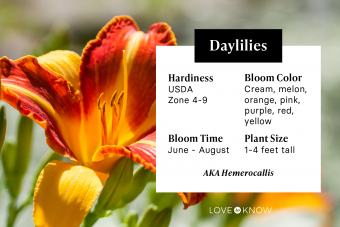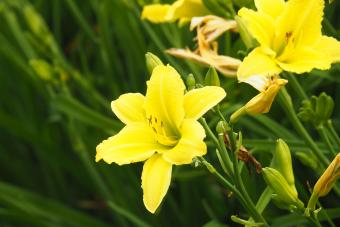
If you're looking for a low-maintenance way to add beautiful blooms to your summer garden, you can't go wrong with daylilies. These fast-growing perennials are sturdy, long-lasting, and require almost no care. Their blooms are gorgeous and add color and interest to any outdoor area. Each bloom typically lasts only one day, but these plants bloom profusely throughout the summer.
Growing Daylilies in Your Garden

There's no good reason not to add daylilies to your garden. These long-lasting perennials are hardy in USDA Zones 4-9 and make a great addition to any landscape.
When to Plant Daylilies
You can plant potted daylilies at any time during the spring, summer, or early fall. If you are planting bare-root daylilies, they should be planted while still dormant in the early spring.
Where to Plant Daylilies: Light and Soil Requirements
Daylilies grow best in full sun. They prefer slightly acidic soil that has a high level of organic matter and that is moist and well draining. However, they aren't picky. Daylilies will do well with less sun and in just about any kind of soil.
- For optimal flower production, daylilies need 6+ hours of full sun, but they will also be fine in partial shade.
- When planted in part shade, daylilies will produce fewer flowers than they would if they were in full sun.
- Daylilies do not do well in full shade. Avoid planting them under dense trees or thick shrubs, as well as in any other heavily shaded areas.
Watering and Fertilizing
Once daylilies are established, they don't need much water or fertilizer. Light watering during dry spells and annual fertilization is generally all daylilies need.
- If planting daylilies in soil that is not already rich in organic matter, work in some manure or compost before planting.
- Work a slow-release fertilizer, such as Schreiner's Gardens Natural Based Daylily Food, to the planting soil.
- Water daylilies thoroughly as soon as they are planted to help the roots get established.
- During dry periods, make sure daylilies get about an inch of water each week.
- Fertilize daylilies once in the spring. Use a slow-release fertilizer and compost or manure.
Pruning Daylilies
Daylilies should be cut back at least once per year, either before or after the summer growing season. You can also prune them a few times during the peak blooming season in order to keep your plantings as tidy as possible.
- Use pruning shears to snip off spent stems at the base of the plant.
- Use shears or a knife to cut and remove brown or otherwise damaged leaves from the plant. Cut them off just a few inches above the ground.
- Put the spent stems and leaves in your compost pile or bin (assuming they are free from pests and disease), or throw them away.
Daylily Pests and Diseases
Pests and diseases aren't generally a huge issue with daylilies, but there are a few disease and pest concerns.
Daylily Diseases
Daylily plants can experience both bacterial and fungal diseases. Common examples include:
- Daylily leaf streak - When daylily leaves develop long yellow streaks paired with browning that starts at the tip and advances along the vein, this is a visible indicator of leaf streak, which is a fungal disease. When a daylily develops leaf streak, it's important to remove and destroy infected leaves. Use a fungicide to help control or prevent leave streak.
- Rust - When a daylily develops bright yellow streaks or spots on the top of its leaves along with yellowy-orange spores on the bottom of its leaves, it has the fungal infection called rust. Affected leaves should be removed and destroyed. As with leaf streak, apply fungicide to help protect plants from further damage.
- Crown rot - Also referred to as soft rot, crown rot is a type of bacterial rot that occurs at the base of daylily plants and below ground in their rhizomes. The bacteria that causes crown rot commonly lives in soil, becoming problematic when temperatures are extremely high or when there is a lack of sufficient soil drainage and air circulation. The base of daylilies that have crown rot often smells bad.
Common Daylily Pests
Several common and pervasive garden pests can infest daylilies. Examples include.
- Thrips - These insect pests like to feed on the buds of daylily flowers, which causes the buds to die before they can bloom. Thrips are tiny dark insects with fringed wings. The leaves of daylilies that are infested with them develop silvery spots or streaks, then turn brown and die.
- Slugs and snails - These garden pests like to feed on young daylily leaves, chewing holes in or gnawing at the edges of leaves. They are most problematic during the springtime. A sure sign of snail or slug infestation is when there are shiny trails of slime on the leaves of daylilies.
- Aphids - These tiny soft-bodied insects tend to target daylilies during early spring, when these plants put on new growth. Aphids use their mouthparts to suck the sap out of a plant's leaves and buds, which causes growths to form on flower buds and leaves to become deformed. Their presence also leads to sooty mold (a fungus) growing on plants.
- Spider mites - Like aphids, spider mites will infest daylilies and suck out their sap. They are likely to strike during particularly hot, dry conditions. When daylily leaves develop yellow spots, that is a sign of spider mite infestation. As the problem worsens, the spots run together such that entire leaves lighten in color and die.
Propagating Daylilies
Daylilies propagate very easily, as they multiply on their own. To propagate your daylilies, you'll simply need to dig up clumps of daylilies and divide them by separating the rhizomes. There will be a lot more plants in each bed than you originally planted.
- You can divide daylilies in late winter or early spring or after they stop flowering in late summer or autumn.
- Replant individual plants where you'd like to have more daylilies. Gently separate the roots, then pot or replant.
- If you divide your daylilies in fall, be sure you re-plant them at least six weeks in advance of winter.
When Do Daylilies Bloom?
Do daylilies bloom all summer? The answer is yes and no. Most individual daylily plants bloom for only a few weeks (up to five), but daylily plants don't all bloom at the same time. Some start earlier than others; some newer cultivars even bloom multiple times throughout the summer. By planting varieties that bloom at different times, you can have daylily blooms in your garden all summer long.
Beautiful Daylilies to Grow in Your Garden
There are many different types of daylilies, including over 35,000 registered cultivars. Flower size varies greatly and comes in many colors, including various shades of cream, melon, orange, pink, purple, red, and yellow. Popular examples include:
Bela Lugosi Daylily

Bela Lugosi (Hemerocallis 'Bela Lugosi) daylilies are deep purple with a splash of bright yellow in the center. They grow to nearly three feet tall. They bloom mid to late summer.
Long Yellow Daylily

Long yellow daylilies (Hemerocallis citrina) are also referred to as citron daylilies. They are bright yellow and can grow up to four feet tall. They are mid-season bloomers.
Orange Daylily

Orange daylilies (Hemerocallis fulva) are sometimes called tawny daylilies. Their flowers are orange and can grow to a height of 30 inches. They bloom in mid to late summer.
Pink Damask Daylily

Pink damask (Hemerocallis 'Pink Damask') daylilies produce beautiful deep pink flowers and grow to about three feet in height. They bloom in mid to late summer.
Stafford Daylily

The flowers of Stafford (Hemerocallis 'Stafford') daylilies are mostly deep red, with yellow and orange highlights. They can grow up to 28 inches tall. They bloom in mid-season.
Good Companions for Daylilies
When choosing companions for daylilies, it's important to pair them with other plants that share similar soil and light requirements. The following plants make great companions for daylilies:
- Black-eyed Susan (Rudbeckia hirta)
- Coneflower (Echinacea)
- Lavender (Lavandula)
- Tickseed (Coreopsis)
- Yarrow (Achillea millefolium)
Daylilies Add Perennial Beauty to Your Garden
Daylilies are a gorgeous addition to any garden. Not only are they gorgeous, but they will also thrive with very little attention. A garden can never have too many daylilies! Go ahead and add some of these low-maintenance perennials to your garden today.







